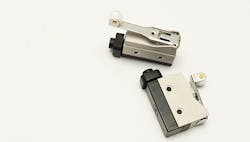This column is moderated by Béla Lipták, automation and safety consultant and editor of the Instrument and Automation Engineers' Handbook (IAEH). If you have an automation-related question for this column, write to [email protected].
Q: I'm a mechanical engineering student at the University of California San Diego working on designing an electric go kart that has both manual and autonomous modes. I came across your column at controlglobal.com and was hoping to get clarification on switch designs for such applications. We want a switch that can turn off autonomous control and turn on hardware for manual control (e-clutch for example) simultaneously. My research suggests looking for a normally closed (NC) or normally open (NO) single-pole, double-throw (SPDT) switch, but I'm having trouble confirming this without prior knowledge. Would you have further insight for switching that isn't sequential but is autonomous?
Adrian Castane
university student
[email protected]
[Note from Béla Lipták: This "simultaneous" feature often isn't provided in controlling backup power supplies or self-driving cars.]
A1: I'd recommend using a double-pole, double-throw (DPDT) switch, and wire the NO contact for the autonomous mode and the NC contact for the safest condition—probably manual mode. That would facilitate “failsafe” wiring because a broken-wire condition won't result in switching to the autonomous mode, and would keep the manual mode as the default position.
Brad Carlberg
consulting professional control systems engineer
BSC Engineering
251-454-1200; [email protected]
A2: This is another question that looks simple but isn't. It depends on the design. Review the circuit diagrams, logic drawings and text to see if a simple switch is even possible. I was asked this question once. When I explained that the design cost, documentation and installation would greatly increase the cost of the control system, it went away. This is a major design specification.
That said, I can' imagine that a manual/auto selection isn't included in most control systems. You just have to discover where and how. I suspect that a three-position switch is needed—stop-manual-auto. Then count the wires and see what you need. Switches are available for almost any required selection and function.
Cullen Langford
process control consultant
[email protected]
A3: Usually, the choice of switches is based on what you want done in most industrial applications you encounter. Keep in mind that a NO switch can be set up for failsafe operation.
The reason for this is, when a NC switch fails, it will show the NC condition. However, when a NO switch fails (caused for example by a short circuit), it shows a closed condition tht would indicate a failure. Read the material at https://instrumentationtools.com/failsafe-wiring-practices for a detailed discussion.
Alejandro (Alex) Varga Meder
senior project manager
[email protected]/[email protected]
Troubleshooting thermocouples
Q: I'm studying your handbook about Type J double-ungrounded thermocouples (TC). We have two installed close together and their installation, including insertion length, is the same. Normally, the temperature is between 103-109 °C. The issue we're having is happening only between 8 and 11 a.m., when one of the TCs reports 125 °C and the other 115 °C, causing a safety interlock to shut down the process. In other hours, they work well. What would you suggest?
F. Alcala
instrumentation engineer
[email protected]
A1: If this was a new installation, my recommendation would be to use an RTD or fiber-optic detector instead of a TC. Further, given the use of a TC, it would have been better to use a transmitter, and install it right on top of the thermowell. I understand that you don't have transmitters, and the TC signals are routed directly to their readout devices (in the control room or elsewhere). In such a case, the long extension wires can cause errors because of noise interference, guarding, shielding or grounding defects. You don't say if the lead wires from the two thermocouples are run separately or in multi-pair extension cables and whether they're individually or overall shielded or both.
In my comments below, I'll assume they're running separately.
In finding the cause of the error that occurs between 8 and 12 a.m., I'd first switch the readout end of the extension wires, and if the readings also switch, I'd conclude that the cause of the error isn't in the readout but elsewhere. Next, I'd switch the lead wires at the sensor end, and if the readings don't switch, the cause is probably in the extension wires. This fault could be an intermittent open circuit or contact failure at the terminal block or an electrical noise interference.
Next, I'd review the process and look for events that occur only between 8 and 12 a.m. Check if the process itself or any electrical devices in its vicinity are turned on or off only during that period, or if some vibration source is activated only at that time. In ungrounded junction designs (Figure 1), the lead wire is physically insulated from the sheath, but it's theoretically possible for an external vibration to cause the temporary opening of some contact.
Figure 1: Grounded thermocouples provide increased protection from electrical interferences.
The TC signal is very weak, on the order of 10 mV. In some cases, a one-degree temperature change results only a few dozen millionths of a volt change in output. Therefore, even a small amount of noise can change that output. Static noise occurs when voltage sources, such as power lines, are capacitively coupled to the wires. Wires such as these should be protected by shielding. Power lines, relays, motors, generators, etc can also cause magnetic noise. This can be minimized by twisting the wires.
Béla Lipták
[email protected]
A2: Electrical feedback, noise or ground issues can affect readings by TCs. I'd recommend this test to isolate faults:
- Disconnect the wires of the TC and connect them to a similar TC, but not installed in the thermowell.
- Check if there are any changes from ambient temperature. If you have noise, feedback or ground issues, the ambient TC will react in a fashion similar to the one in the thermowell.
- If the thermocouple signal holds steady with no variations, the issue could be with the thermocouple in the well.
- Verify there's no signal feedback that can cause noise or interference with the installed thermocouple.
- Finally, remove the installed thermocouple and bench test that there's no drifting of the signal.
Steps 1 and 2 will show if the TC cable has any issues. Steps 2, 3 and 4 check for external or internal faults in the TC itself. Step 5 directly verifies if the TC is in good condition or not.
Alejandro (Alex) Varga Meder
senior project manager
[email protected]/[email protected]
A3: I'd suggest checking the following:
- Switch the signal lines from TC ends. If you find the problem is transferring to another loop, the issue isn't at the TC or sensor.
- Now switch over at the junction box and observe the same.
- Switch over from barrier and observe the same.
This way, you'll find out the section responsible. I suspect the issue is with grounding or the I/O channel.
Debasis Guha
instrument engineer, [email protected]
A4: With thermocouples and RTDs, wiring is critical. For challenging applications, you might want to consider a fiber-optic temperature sensor. GaAs temperature probes are based on the inherent relationship of band gap energy to temperature. Because temperature is measured in the spectral domain, fiber-optic “wiring” has no effect on measurement accuracy.
Dennis Horwitz
control consultant, [email protected]
About the Author
Béla Lipták
Columnist and Control Consultant
Béla Lipták is an automation and safety consultant and editor of the Instrument and Automation Engineers’ Handbook (IAEH).

Leaders relevant to this article:



